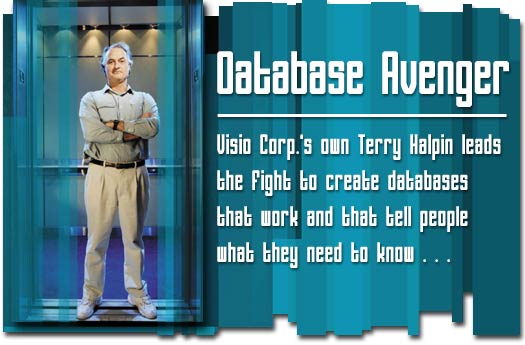
By Ellen Wixted


By Ellen Wixted
| "There's so much bad database design in the world," Dr. Terry Halpin says in his soft Australian drawl. "The problem is that the people who understand what the database needs to do are businesspeople, and the people who actually build the system are techies. There's often a communication breakdown, and what results are systems that don't work as well as they could." |
 Halpin's mission is to eradicate bad database design, and his method is to
lift information modeling to a level that is truly conceptual, yet retains the rigor
of formal logic. Halpin, Visio Director of Database Strategy, brings more
than three decades of academic and industry experience to this role. With
degrees in physics, mathematics, education, and philosophy—not to mention a Ph.D.
in computer science—he's found a way for his interest in logic to span
several disciplines. But since encountering conceptual data modeling for the first
time in the early 1980s, he's become an evangelist.
Halpin's mission is to eradicate bad database design, and his method is to
lift information modeling to a level that is truly conceptual, yet retains the rigor
of formal logic. Halpin, Visio Director of Database Strategy, brings more
than three decades of academic and industry experience to this role. With
degrees in physics, mathematics, education, and philosophy—not to mention a Ph.D.
in computer science—he's found a way for his interest in logic to span
several disciplines. But since encountering conceptual data modeling for the first
time in the early 1980s, he's become an evangelist.
As far as Halpin is concerned, the high-level conceptual modeling supported by Object Role Modeling (ORM) is the answer to communication breakdowns. "ORM makes it possible for businesspeople and database designers to literally speak the same language, so validating a database design is much more straightforward. With ORM, formal logic is accessible to businesspeople, and they're protected by the strength of it." Visio 2000 Enterprise Edition introduces support for ORM in the context of a powerful suite of IT design tools. With Enterprise Edition, implementing conceptual models created in ORM as relational or object-relational database schemas is straightforward.
Eureka!
![]()
In the early '80s, Halpin was introduced to the
Natural language Information Analysis Method (NIAM), an
early ORM variation, at the University of Queensland
in Australia. "It all made sense," he says,
remembering that moment of illumination. Within a year, he
was teaching university courses in conceptual
modeling and had switched the topic of his Ph.D. thesis
from proving theorems automatically to formalizing the
ORM method. As part of his thesis, Halpin worked on
proving schema equivalence. "Two people might model
the same domain in different ways," he explains. "How
do you know that they're describing the same thing?
I was interested in developing an approach that
could formally prove whether two different models
were equivalent." In 1989, Halpin and co-author Dr.
Shir Nijssen, another leading ORM expert, published
the groundbreaking book Conceptual Schema and Relational Database Design.

In 1995, Halpin left his teaching post at the University of Queensland to work full-time in the commercial software industry, where his focus has been on developing database design tools. He's found the change invigorating. "I'm still involved in a number of academic committees, so I stay up-to-date on state-of-the-art research. And while I miss teaching, I don't miss marking exam papers and assignments. I reached a point in my academic career where I didn't want to invest energy in research unless it had obvious practical value. It's motivating to work in an industry where you can see the immediate use of your research."
The Visio era
![]()
At Visio Corp. these days, Halpin is researching
ways that ORM can be used to create conceptual models
of complex object-oriented software design projects.
"As the Unified Modeling Language, or UML,
gains popularity, the higher-level
conceptual-analysis approach of ORM can help software designers
capture and validate the business rules relevant to
their application in much the same way it's helpful
to database designers."
The geographic change has been a welcome one, too. "I really love the environment here in Seattle," Halpin says. "It's gorgeous. And the people are even more polite than they are in Oz. Sometimes I miss the beaches at home—it's much too cold to go body-surfing here—but I also love trekking in the mountain forests." In addition to his academic credentials, Halpin holds a black belt in judo and a blue belt in karate. Like many other Seattleites, he cultivates an interest in gardening and reads widely, tackling everything from science fiction to philosophy texts. And with grown children still living in Australia, he and his wife, Norma, travel Down Under regularly.
You can find more information about ORM at
www.orm.net,
the official site for conceptual
data modeling. For an in-depth look at ORM and
conceptual database design, you can order the second edition
of Dr. Halpin's Conceptual Schema and
Relational Database Design by emailing [email protected]. A
third edition of the book will be published in 2001 under the new title Information Modeling and Relational Databases by Morgan Kaufmann Publishers
(www.mkp.com). For details about Visio Enterprise
Edition, visit www.microsoft.com.